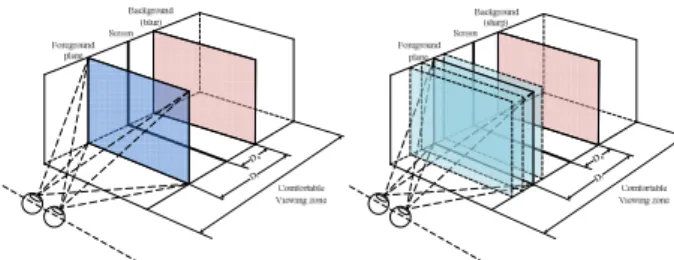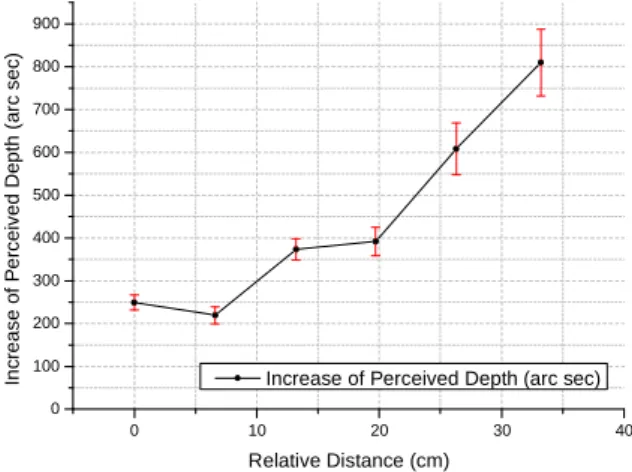HAL Id: hal-00735782
https://hal.archives-ouvertes.fr/hal-00735782
Submitted on 26 Sep 2012
HAL is a multi-disciplinary open access
archive for the deposit and dissemination of
sci-entific research documents, whether they are
pub-lished or not. The documents may come from
teaching and research institutions in France or
abroad, or from public or private research centers.
L’archive ouverte pluridisciplinaire HAL, est
destinée au dépôt et à la diffusion de documents
scientifiques de niveau recherche, publiés ou non,
émanant des établissements d’enseignement et de
recherche français ou étrangers, des laboratoires
publics ou privés.
Clarifying how defocus blur and disparity affect the
perceived depth
Junle Wang, Marcus Barkowsky, Vincent Ricordel, Patrick Le Callet
To cite this version:
Junle Wang, Marcus Barkowsky, Vincent Ricordel, Patrick Le Callet. Clarifying how defocus blur
and disparity affect the perceived depth. First Sino-French Workshop on Education and Research
collaborations in Information and Communication Technologies, May 2011, Nantes, France. pp.1-2.
�hal-00735782�
First Sino-French Workshop on Education and Research collaborations in Information and Communication Technologies
SIFWICT 2011 – May 19 - 20, 2011, Nantes, France
_____________________________________________________________________________________________________________________________________________________________________________
Clarifying how defocus blur and disparity affect the
perceived depth
Junle Wang, Marcus Barkowsky, Vincent Ricordel and Patrick Le Callet
LUNAM Université, Université de Nantes, IRCCyN UMR CNRS 6597 Polytech Nantes *rue Christian Pauc BP 50609 44306, Nantes, France {junle.wang; marcus.barkowsky; vincent.ricordel; patrick.lecallet}@univ-nantes.fr
Abstract—Human visual system takes advantage of different cues
simultaneously to provide us the perception of depth. When 3D images are shown on a planar stereoscopic display, binocular disparity becomes a pre-eminent depth cue. But it induces simultaneously the conflict between accommodation and vergence, which is often considered as a main reason for visual discomfort. If we limit this visual discomfort by decreasing the disparity, the apparent depth also decreases. We propose to decrease the (binocular) disparity of 3D presentations, and to reinforce (monocular) cues to compensate the loss of perceived depth and keep an unaltered apparent depth. The influence of a monocular depth cue, blur, on the apparent depth of stereoscopic scenes was studied in our recent work. We conducted a subjective experiment using a two-alternative forced choice task. Observers were required to identify the larger perceived depth in a pair of 3D images with/without blur. By fitting the result to a psychometric function, we obtained points of subjective equality in terms of disparity. We found that when blur is added to the background of the image, the viewer can perceive larger depth comparing to the images without any blur in the background. The increase of perceived depth can be considered as a function of the relative distance between the foreground and background, while it is insensitive to the distance between the viewer and the depth plane at which the blur is added.
Keywords - 3DTV; Depth perception; Stereoscopic display; Gaussian blur; Subjective experiment;
I. INTRODUCTION
Recently, stereoscopic image and video production is gaining an increasing amount of attention. The displays nowadays used to show these 3D productions are usually planar so that binocular disparity on the display plane becomes a pre-eminent depth cue enabling viewers to perceive depth. As a binocular cue, disparity is stable, but on the current planar displays, it induces a conflict between accommodation and vergence of the eyes. This conflict is usually considered as one main reason for visual discomfort, especially when the disparity is large. If we decrease this binocular cue, disparity, to limit the visual discomfort, the apparent depth also decreases.
Several other depth cues besides binocular disparity affect also the apparent depth. We propose to decrease the (binocular) disparity of 3D presentations, and to reinforce (monocular) cues to compensate the loss of perceived depth and keep an unaltered apparent depth. The limitation of depth-of-field of human eyes causes blur in the retinal image which is known as
an important monocular depth cue. Some previous investigations have shown clear contributions of blur to depth perception[1-4], while others showed that blur has either no effect[5] or only some qualitative effects on perceived depth ordering[6-8].
However, most of the previous literature measures the influence of the blur cue by adding blurriness only at the screen plane, while the depth cues’ magnitude varies as a function of distance. Another limitation in most of the previous studies was the experiment apparatus. CRT monitors were used and this type of displays has some limitations: (1) the surface containing stimuli was slightly curved, (2) the stimuli’s virtual distance was affected by refraction due to the front glass plate, and (3) the screen was usually not large enough to cover a favorable field-of-view. Depending on the monitor used, the speed of the phosphor changes might also have caused crosstalk.
II. EXPERIMENT A. Design and procedure
In our study, we conducted the subjective experiment using a state-of-art stereoscopic display system, the Samsung SyncMaster 2233RZ which is a 22.5-inch 1680*1050@120Hz wide-screen LCD monitor working with active shutter glasses from NVidia. The stimuli used in the experiment contained a background plane and a single object in the foreground, both of which were chosen closer to natural content compared to the stimuli used in previous publications. The image of a butterfly was used as the foreground object, since it is spatially complex enough, containing regions with both low and high frequency.
Figure 1. Schematic diagram of the experiment setup
In our experimental observations, observers viewed stimuli in a two alternative forced choice (2AFC) task, being required to select the stimulus with largest depth interval between
Figure 2. The left views of an sharp-background stimulus and a blur-background stimulus
foreground and background. Two sources of perceived depth are used: disparity and blur. The perceived depth from disparity stems from the difference of disparity between the foreground object and the background. The perceived depth from blur stems from the amount of blur introduced to the background by convolution with a Gaussian kernel (Figure 2). Both the absolute position and relative distance between the foreground and background stay as a free parameter (Figure 1). This setup is able to evaluate how the combination of disparity and blur affects the perceived depth of objects located at different distance. Details of the experiment are described in [9].
B. Result and analysis
We plot the curve of the PSE as a function of the depth interval between the foreground and background in Figure 3. 0 cm means that the foreground and the background are at the same depth. The figure shows a clear increase of perceived depth created by the influence of blur. We can also find that the enhancement of perceived depth increases with increasing depth interval between the fixated sharp foreground object and the defocused blurred background.
0 10 20 30 40 0 100 200 300 400 500 600 700 800 900 In c re a s e o f P e rc e iv e d D e p th ( a rc s e c ) Relative Distance (cm)
Increase of Perceived Depth (arc sec)
Figure 3. Results from the experiment shows the increase of perceived depth as a function of relative distance.
III. CONCLUSION
The experimental result indicates that image blur makes contributions to the impression of depth perceived in stereoscopic images, when measured against depth perceived in
stereoscopic images without blur. The increase of depth can be considered as a function of the relative distance between the fixated foreground ground object and the blurred background, while this increase is insensitive to the distance between the viewer and the depth plane at which the blur is added.
The feasibility of enhancing the perceived depth by reinforcing a monocular cue, namely defocus blur, provides an interesting way to deal with the conflict between vergence and accommodation and when 3D images are shown on a planar stereoscopic display. Generally, the foreground object popping out of the screen is the most important object in the scene, while the large disparity of the object may lead to visual discomfort when it is focused by the observer. Our results show that it is feasible to decrease the disparity of this object without losing the pop-out effect by adding some blur on its background.
IV. ACKNOWLEDGMENT
This research was carried out within the framework of the PERSEE project financed by ANR (project reference: ANR-09-BLAN-0170).
REFERENCES
[1] A. PENTLAND, “A new sense for depth of field,” IEEE Transactions on Pattern Analysis and Machine Intelligence, 9(4), 523-531 (1987). [2] S. Watt, K. Akeley, M. Ernst et al., “Focus cues affect perceived depth,”
Journal of Vision, 5(10), (2005).
[3] D. Hoffman, and M. Banks, “Focus information is used to interpret binocular images,” Journal of Vision, 10(5), (2010).
[4] R. Held, E. Cooper, J. O'Brien et al., “Using blur to affect perceived distance and size,” ACM Transactions on Graphics (TOG), 29(2), 1-16 (2010).
[5] G. Mather, and D. Smith, “Depth cue integration: stereopsis and image blur,” Vision research, 40(25), 3501-3506 (2000).
[6] J. Marshall, C. Burbeck, D. Ariely et al., “Occlusion edge blur: a cue to relative visual depth,” Journal of the Optical Society of America A, 13(4), 681-688 (1996).
[7] G. Mather, “Image blur as a pictorial depth cue,” Proceedings: Biological Sciences, 263(1367), 169-172 (1996).
[8] S. Palmer, and J. Brooks, “Edge–Region Grouping in Figure–Ground Organization and Depth Perception,” Journal of Experimental Psychology, 34(6), 1353-1371 (2008).
[9] J. Wang, M. Barkowsky, V. Ricordel and P. Le Callet, “Quantifying how the combination of blur and disparity affects the perceived depth,” Proceedings of the SPIE, Volume 7865, pp. 78650K-78650K-10 (2011).

